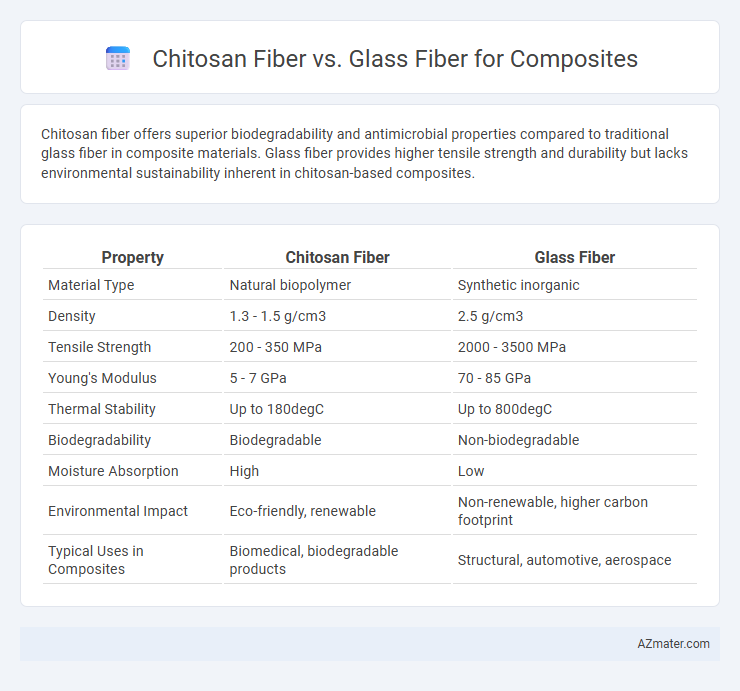Chitosan fiber offers superior biodegradability and antimicrobial properties compared to traditional glass fiber in composite materials. Glass fiber provides higher tensile strength and durability but lacks environmental sustainability inherent in chitosan-based composites.
Table of Comparison
| Property | Chitosan Fiber | Glass Fiber |
|---|---|---|
| Material Type | Natural biopolymer | Synthetic inorganic |
| Density | 1.3 - 1.5 g/cm3 | 2.5 g/cm3 |
| Tensile Strength | 200 - 350 MPa | 2000 - 3500 MPa |
| Young's Modulus | 5 - 7 GPa | 70 - 85 GPa |
| Thermal Stability | Up to 180degC | Up to 800degC |
| Biodegradability | Biodegradable | Non-biodegradable |
| Moisture Absorption | High | Low |
| Environmental Impact | Eco-friendly, renewable | Non-renewable, higher carbon footprint |
| Typical Uses in Composites | Biomedical, biodegradable products | Structural, automotive, aerospace |
Introduction to Composite Reinforcement Fibers
Chitosan fiber and glass fiber serve as reinforcement materials in composite fabrication, each offering distinct advantages. Chitosan fiber, derived from abundant biopolymers, provides biodegradability, lightweight properties, and good interfacial bonding with polymer matrices. Glass fiber, known for its high tensile strength, durability, and cost-effectiveness, remains the industry standard for enhancing mechanical performance and structural integrity in composites.
Overview of Chitosan Fiber
Chitosan fiber, derived from chitin in crustacean shells, exhibits exceptional biodegradability and antimicrobial properties, making it a sustainable alternative to glass fiber in composites. Its lightweight structure and high tensile strength contribute to enhanced mechanical performance and environmental benefits compared to non-biodegradable glass fiber composites. Chitosan fiber composites are increasingly favored in biomedical, automotive, and packaging applications due to their eco-friendly characteristics and functional versatility.
Overview of Glass Fiber
Glass fiber is a widely used reinforcement material in composite manufacturing due to its high tensile strength, excellent thermal stability, and cost-effectiveness. It offers superior mechanical properties such as enhanced stiffness and impact resistance, making it suitable for automotive, aerospace, and construction industries. Compared to chitosan fiber, glass fiber provides greater durability and chemical resistance, but it lacks biodegradability and environmental sustainability.
Mechanical Properties: Chitosan vs Glass Fiber
Chitosan fibers exhibit lower tensile strength and modulus compared to glass fibers, limiting their application in high-stress composite structures. Glass fibers provide superior mechanical properties such as higher tensile strength, stiffness, and impact resistance, making them the preferred reinforcement in composites requiring durability and load-bearing capacity. However, chitosan fibers offer advantages in biodegradability and lightweight applications where moderate mechanical performance is acceptable.
Biocompatibility and Biodegradability Comparison
Chitosan fiber exhibits superior biocompatibility compared to glass fiber, making it ideal for biomedical composite applications where tissue interaction and minimal immune response are critical. The biodegradability of chitosan fibers allows composite materials to naturally degrade over time, reducing environmental impact and eliminating the need for secondary disposal procedures, unlike inert glass fibers which persist in the environment. This biodegradability coupled with non-toxic nature positions chitosan fibers as a sustainable alternative to traditional glass fibers in eco-friendly composite design.
Processing and Manufacturing Differences
Chitosan fiber in composites offers biodegradable and eco-friendly processing, requiring gentle solvent-based spinning methods at lower temperatures compared to glass fiber, which demands high-temperature melting and weaving due to its silica-based composition. Manufacturing chitosan fiber composites involves environmentally sustainable solvent casting or wet spinning techniques, while glass fiber composites rely heavily on energy-intensive processes like pultrusion and filament winding. The lower thermal resistance of chitosan fibers limits processing temperatures, influencing resin compatibility and curing cycles distinct from the high-temperature tolerance and mechanical reinforcement characteristics of glass fibers.
Environmental Impact and Sustainability
Chitosan fiber, derived from renewable marine sources like crustacean shells, offers significant environmental benefits over traditional glass fiber composites by being biodegradable and reducing reliance on non-renewable minerals. Glass fiber manufacturing involves high energy consumption and emits greenhouse gases, whereas chitosan fiber production has a lower carbon footprint and promotes circular economy principles through waste valorization. Sustainable composite design increasingly favors chitosan fibers for their eco-friendly degradation and minimal ecological toxicity compared to the persistent environmental impact of glass fiber disposal.
Cost Analysis: Chitosan Fiber vs Glass Fiber
Chitosan fiber offers a competitive cost advantage over glass fiber in composite manufacturing due to its renewable sourcing and lower energy-intensive production processes. While glass fiber remains cheaper per kilogram, chitosan's biodegradability and lower disposal costs contribute to reduced total lifecycle expenses. Cost analysis reveals that chitosan fiber composites can achieve cost efficiency through environmental benefits and material sustainability, despite higher initial raw material pricing.
Applications in Industry and Medicine
Chitosan fiber offers biocompatibility and biodegradability, making it ideal for medical applications such as wound dressings, tissue engineering, and drug delivery systems where natural fiber integration is critical. Glass fiber provides superior tensile strength and thermal resistance, widely used in automotive, aerospace, and construction industries for lightweight yet durable composite materials. The choice between chitosan and glass fiber hinges on the balance of mechanical performance and biological compatibility required by the specific application.
Future Prospects and Research Trends
Chitosan fiber, derived from renewable sources, is gaining attention in composite materials for its biodegradability and biocompatibility, offering a sustainable alternative to traditional glass fiber. Emerging research focuses on enhancing chitosan fiber's mechanical properties and compatibility with polymer matrices through chemical modification and nano-reinforcement techniques. Future prospects highlight the development of hybrid composites combining chitosan and glass fibers to optimize strength, environmental impact, and cost-effectiveness in aerospace and automotive applications.

Infographic: Chitosan fiber vs Glass fiber for Composite
 azmater.com
azmater.com